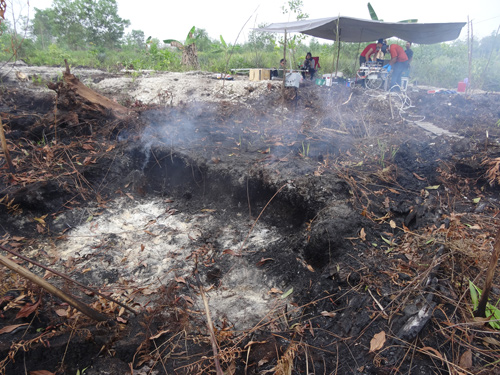Last fall, fires driven by extreme El Niño conditions swept through the peatlands of Indonesia’s Central Kalimantan province, with catastrophic effects on air quality throughout Southeast Asia, including air pollution up to 10 times the level considered hazardous to human health and visibility in some areas reduced to 50 meters.
Emissions from fires like these have given Indonesia a notorious place on the list of the world’s biggest contributors to climate change—it’s currently ranked the third worst. A NASA-funded collaboration between Indonesian and American scientists, however, has found evidence that questions this ranking. Preliminary results presented last week at the Society of Wetland Scientists’ annual meeting in Corpus Christi, Texas, suggest that Indonesia’s peat fires may produce less greenhouse gas than previously believed.
Up in Smoke
Indonesia—primarily Kalimantan, the Indonesian region of Borneo—is home to half of the world’s tropical peatlands.
Peat forms in wetlands where wet, oxygen-poor conditions prevent plant material from fully decomposing. As generations of plants grow, die, and then only partially decompose, their remains pile up into a thick layer of organic matter, called peat, which acts as a carbon sink.
Indonesia—primarily Kalimantan, the Indonesian region of Borneo—is home to half of the world’s tropical peatlands. In the mid-1990s the Indonesian government’s Mega Rice Project drained and cleared more than a million hectares of Kalimantan’s peat forest in an unsuccessful attempt to convert it to agriculture, which has led to widespread annual fires in the region as the carbon-rich peat dries out and becomes flammable.

In fall 2015 a particularly strong El Niño drove severe dry conditions in the region that led to the worst fires in nearly 20 years, with particulate pollution from the smoke reaching 10 times the amount considered hazardous to human health. Current estimates of the amounts of various greenhouse gases produced by peat fires come from lab experiments, and on the basis of those, Indonesia’s fires make it the world’s third-biggest carbon emitter. Without its forest fires, however, Indonesia would rank around 22nd, according to Erianto Putra of South Dakota State University in Brookings, the climate scientist who presented the data at last week’s meeting.
To obtain a more accurate, field-based analysis of the smoke’s components, Putra’s colleagues imported a portable infrared spectrometer and other equipment into Indonesia from the United States. The researchers took the spectrometer out into still smoldering peatlands, where they collected samples of the smoke and analyzed its makeup.
“Our ministry of forestry is working on monitoring greenhouse gas emissions, but they still have questions about the emissions from peatland fires,” says Putra. “We are the first to conduct research on the smoke from peat fires in Indonesia, and we want to fill in this critical gap” by answering the ministry’s questions.
Understanding Peat Fires
Preliminary results show that burning peat emits 8% less carbon dioxide and 55% less methane than previously believed. While this doesn’t make the most recent fires’ impacts on Southeast Asia any less catastrophic, it does mean that Indonesia may be shouldering an unfair share of blame for the world’s carbon woes.
Fires in degraded peatlands like the drained peat swamp forests of Indonesia have a profound influence on the environment, both locally and globally.
“Fires in degraded peatlands like the drained peat swamp forests of Indonesia have a profound influence on the environment, both locally and globally,” said plant ecologist Brian Benscoter of Florida Atlantic University, in Boca Raton, chair of the Society of Wetland Scientists’ peatlands section. The prolonged smoldering of the dense organic soil, he explained, produces heavy smoke that can remain low in the atmosphere for long periods, creating visibility hazards and threatening the health of local communities.
“Research like that of Dr. Putra and his colleagues is helping to inform gaps in our current understanding of smoke emissions during peatland burning in tropical peatlands and beyond,” Benscoter said. The peat fires offer “a strong and compelling example of what can happen in degraded peatlands and why these important ecosystems need to be restored or conserved globally.”
—Rebecca Heisman, Freelance Science Journalist; email: [email protected]
Correction, 10 June 2016: An earlier version of this article incorrectly reported in its teaser that Indonesia’s ranking as a carbon-emitting nation could fall to lower than 20th on the basis of recent field measurements showing reduced greenhouse gas emissions from peat fires. That mistaken assertion has been removed from the updated article.
Citation:
Heisman, R. (2016), The 2015 Indonesian fires: Less carbon release than was thought, Eos, 97, https://doi.org/10.1029/2016EO053903. Published on 09 June 2016.
Text © 2016. The authors. CC BY-NC-ND 3.0
Except where otherwise noted, images are subject to copyright. Any reuse without express permission from the copyright owner is prohibited.

